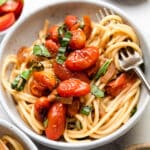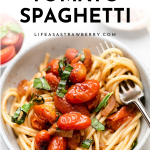Description
This easy, silky burst tomato spaghetti is ready in 30 minutes with fresh summer tomatoes and a few pantry staples.
Ingredients
- 1/2 pound spaghetti
- 1 Tablespoon olive oil
- 1 pint cherry tomatoes (about 2 heaping cups)
- 1 large shallot, sliced (about 1/2 cup)
- 2 cloves garlic, minced
- 1/2 cup dry white wine (we used a Chardonnay)
- 1/2 packed cup fresh basil, sliced, plus extra for garnish
- 1/2 of a large lemon
- Salt and pepper to taste
Instructions
- Cook pasta in a large pot of very salty water until al dente.
- While the pasta cooks, heat olive oil in a large, heavy skillet (we like cast iron) over medium-high heat.
- When oil shimmers, add cherry tomatoes and cook, stirring only once or twice, for 3-4 minutes until skins have blistered and begun to burst. Note: Tomatoes can pop and splatter as they cook: keep an eye on them and use a splatter screen if you like!
- Add shallot and garlic to the skillet and give everything a good stir. Cook until the shallots have softened, about 1 minute. Note: The pan will be hot at this point, so the shallots will cook pretty quickly: make sure you have the rest of your ingredients ready to go!
- When shallots have softened, add a pinch of salt and the white wine. Bring to a simmer and cook until wine has reduced by not quite half.
- Reserve ½ cup of pasta water, then drain spaghetti and add the cooked pasta to the skillet with your tomato mixture. Use tongs to toss the pasta with the sauce until it’s evenly coated.
- Add reserved pasta water a Tablespoon or two at a time, using tongs to toss in between each addition. You won’t need the full amount of reserved pasta water!
- Add basil and a squeeze of lemon juice and toss to combine. Taste and add salt and pepper if needed.
- Remove from heat. Garnish with more basil and a few turns of cracked black pepper. Serve immediately!
Notes
Substitutions. Use onions instead of shallots. Use vegetable or chicken stock in place of the dry white wine. Swap heavy cream, butter, or cauliflower cream for the pasta water if you prefer. Use any pasta you have on hand or omit the starch altogether and serve with zoodles or spaghetti squash! Swap parsley or sage for some or all of the basil here if you like.
Additions. Add fresh kale or spinach at the end of cooking for a pop of color. Add drained butter beans or chick peas for extra protein (if you’re a meat eater or pescetarian, you can also add chicken, Italian sausage, shrimp/prawns, clams, or mussels to this recipe). Add zucchini, squash, grilled corn, garlic scapes, bell peppers, or any other summer veggies you have lying around to make this a bit heartier! Top this pasta with some parmesan cheese if you like.
What if I don’t have cherry tomatoes? You can use 2 cups of roughly chopped tomatoes instead. They won’t blister like the cherry tomatoes, but you can still cook at high heat for 3-4 minutes to get that deeper flavor. You can also use 1/2 cup of canned tomato sauce instead of the cherry tomatoes for a smoother sauce.
How much spaghetti should I make per person? As written, this recipe is usually perfect for 2 people if we don’t have any other sides. If we serve it with salad, bread, or another side dish/dessert, it’s typically enough for 4 people.
Taste as you go! Not all salts (and not all palettes!) are the same. Make sure to taste the pasta before serving and add salt and pepper as necessary (and remember that the pasta water will add some salt as well!) With so few ingredients, seasoning becomes extra important here.

